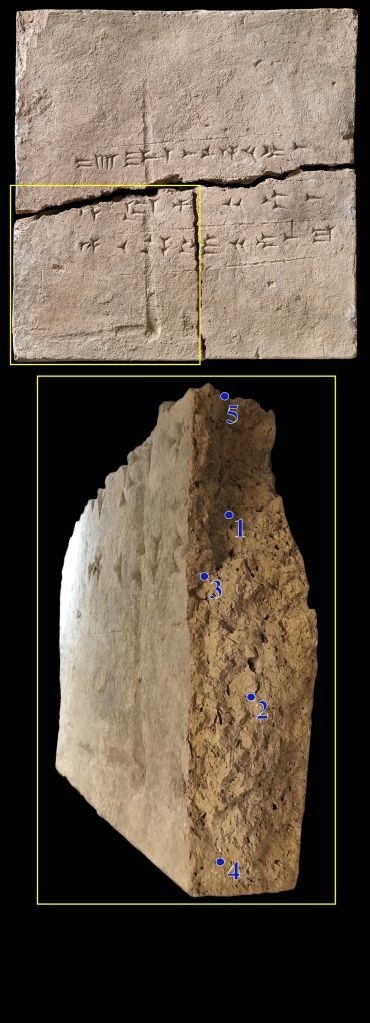Reviewed by Danielle Ellis, B.Sc.Aug 23 2023
Scientists from the University of Oxford have succeeded in achieving the first successful extraction of ancient DNA from a 2,900-year-old clay brick. The study, which was published today in Nature Scientific Reports, offers an intriguing insight into the diversity of plant species cultivated at that time and place and could pave the way for similar studies on clay material from other locations and time periods.
 The clay brick from the National Museum of Denmark from which the samples were derived. Image Credit: Arnold Mikkelsen and Jens Lauridsen.
The clay brick from the National Museum of Denmark from which the samples were derived. Image Credit: Arnold Mikkelsen and Jens Lauridsen.
The clay brick, which is now on display at the National Museum of Denmark, came from the palace of Neo-Assyrian king Ashurnasirpal II in the ancient city of Kalhu. The construction of the North-West Palace in Nimrud (modern-day northern Iraq) began around 879 BCE.
The brick bears a cuneiform inscription (written in the now-extinct Semitic language Akkadian) that reads, “The property of Ashurnasirpal, king of Assyria.” This allows the brick to be precisely dated to within a decade (879 BCE to 869 BCE).
The team of scientists was able to obtain samples from the inner core of the brick during a digitalization project at the Museum in 2020, indicating that there was a low risk of DNA contamination since the brick was created. The DNA was extracted from the samples using a protocol previously developed for other porous materials like bone.

Image Credit: Billion Photos/Shutterstock.com
The researchers observed 34 distinct taxonomic groups of plants after sequencing the extracted DNA. Brassicaceae (cabbage) and Ericaceae (heather) were the plant families with the most abundant sequences. Betulaceae (birch), Lauraceae (laurels), Selineae (umbellifiers), and Triticeae (cultivated grasses) were also represented.
Researchers were able to correlate their observations with modern-day botanical records from Iraq and also ancient Assyrian plant descriptions, thanks to their interdisciplinary team of assyriologists, archaeologists, biologists, and geneticists.
The majority of the brick would have been made from mud collected nearby the Tigris River, combined with chaff, straw, or animal dung. It would have been molded into shape before being written on in the cuneiform script and drying in the sun. The genetic material locked inside the clay would have been preserved because the brick was never burned and was instead allowed to dry naturally.
We were absolutely thrilled to discover that ancient DNA, effectively protected from contamination inside a mass of clay, can successfully be extracted from a 2,900-year-old brick. This research project is a perfect example of the importance of interdisciplinary collaboration in science, as the diverse expertise included in this study provided a holistic approach to the investigation of this material and the results it yielded.”
Dr Sophie Lund Rasmussen, Study Joint First Author, Wildlife Conservation Research Unit, Department of Biology, University of Oxford
Apart from the interesting insight revealed by this single brick, the study serves as a proof of concept and method that could be applied to many other archaeological sources of clay from various places and time periods around the world to pinpoint past flora and fauna. Clay materials are almost always prevalent in any archaeological site around the world, and because of their context, they can often be dated precisely.
This research only outlined the plant DNA that was extracted because these were the most common and well-preserved specimens. However, based on the sample, all taxa, including vertebrates and invertebrates, could possibly be identified.
The capacity to provide accurate descriptions of ancient biodiversity would be a valuable tool for better understanding and quantifying current biodiversity loss, as well as for developing a greater understanding of ancient and lost civilizations.
Because of the inscription on the brick, we can allocate the clay to a relatively specific period of time in a particular region, which means the brick serves as a biodiversity time-capsule of information regarding a single site and its surroundings. In this case, it provides researchers with a unique access to the ancient Assyrians.”
Dr Troels Arbøll, Study Joint First Author and Junior Research Fellow, Faculty of Asian and Middle Eastern Studies, University of Oxford
Source:
Journal reference:
Arbøll, T. P., et al. (2023). Revealing the secrets of a 2900-year-old clay brick, discovering a time capsule of ancient DNA. Scientific Reports. doi.org/10.1038/s41598-023-38191-w.